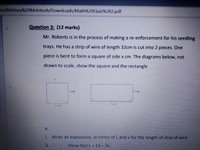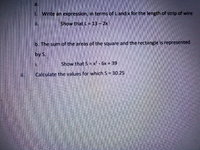You are using an out of date browser. It may not display this or other websites correctly.
You should upgrade or use an alternative browser.
You should upgrade or use an alternative browser.
Need urgent help
- Thread starter Brittney
- Start date
Otis
Elite Member
- Joined
- Apr 22, 2015
- Messages
- 4,414
Hi Brittney. At first, I was confused myself. The exercise statement could be better worded, and using symbols l and L to mean the same thing is not good.i have no idea what to do
Let's ignore the statement about reinforcing seedling trays (whatever it has to do with squares and rectangles). Here's my rewording of the exercise:
A 32cm length of wire is cut in two pieces. The first piece is bent into a square; the second piece is bent into a rectangle. As shown in the diagram, the square has side length x, and the rectangle measures 3 by L.
a(i) Write an equation in terms of L and x, for the original length of wire.
a(ii) Use the equation in part a(i) to show that L = 13 - 2x
Let S represent the sum of the areas of the square and rectangle.
b(i) Show that S = x^2 - 6x + 39
b(ii) Calculate values for x and L, when S = 30.25
For part a(i), use the fact that the original length of the wire equals the perimeter of the square plus the perimeter of the rectangle.
Part a(ii) asks us to solve the equation in part a(i) for L.
For part b(i), first write expressions for the area of the square and the area of the rectangle. (For the rectangle's area, use the expression 13-2x instead of symbol L.) Then add the two area expressions.
Part b(ii) requires us to first solve the equation in part b(i), using S=30.25 (doing that yields possible values for x). For each x-value, we find the corresponding L-value, by using the equation in part a(ii).
If you're still confused, please explain where. Otherwise, if you need more help, please show your work so that we can see what you tried and how far you got. We'll continue from there.
?
Steven G
Elite Member
- Joined
- Dec 30, 2014
- Messages
- 14,383
You are given the length of each side of the square as well as the lengths of the sides of the rectangle. Add up the length of the eight sides and think about why this sum should be the length of the wire. Then equate the two. Then solve for x.
Otis
Elite Member
- Joined
- Apr 22, 2015
- Messages
- 4,414
Jomo, I can't tell which of the four parts you're talking about, but how can we solve for x without knowing L?… Then solve for x.
Bad problem statements confuse students. Really bad problem statements confuse everyone.
Create an expression to describe the length of the wire? Why bother? The length of the wire is 32. I suspect that whoever wrote this problem meant to create an expression to equate to the length of the wire.
Write an expression in x and L to equate to the length of the wire.
[MATH]4x + 2L + 2 * 3 = 32[/MATH].
From that show that the equation can be simplified to
[MATH]L = 13 - 2x.[/MATH]
This is so obvious that a student wonders if she even understands what is meant.
Then the student is supposed to construct a formula for the sum of the areas of both quadrilaterals. Why not say so clearly?
[MATH]S = x^2 + 3L = x^2 + 3(13 - 2x) = x^2 - 6x + 39.[/MATH]
Having done so, the student is supposed to find x and L on the supposition that the area is 30.25. But that is implied by “Find the values.” The values of the areas, of the length of the original wire, or the dimensions of the two quadrilateral, the values of what?
Here is how I would state the problem.
A piece of wire is 32 cm long and is cut into 8 pieces, 4 of which are used to construct a square with sides of length x and the remaining 4 are used to construct a rectangle with sides of length 3 and L. The combined area of square and rectangle are 30.25 cm^2. What are the dimensions of each quadrilateral?
Notice that this version gives nothing away and makes the student do some algebra. It is also comprehensible.
Create an expression to describe the length of the wire? Why bother? The length of the wire is 32. I suspect that whoever wrote this problem meant to create an expression to equate to the length of the wire.
Write an expression in x and L to equate to the length of the wire.
[MATH]4x + 2L + 2 * 3 = 32[/MATH].
From that show that the equation can be simplified to
[MATH]L = 13 - 2x.[/MATH]
This is so obvious that a student wonders if she even understands what is meant.
Then the student is supposed to construct a formula for the sum of the areas of both quadrilaterals. Why not say so clearly?
[MATH]S = x^2 + 3L = x^2 + 3(13 - 2x) = x^2 - 6x + 39.[/MATH]
Having done so, the student is supposed to find x and L on the supposition that the area is 30.25. But that is implied by “Find the values.” The values of the areas, of the length of the original wire, or the dimensions of the two quadrilateral, the values of what?
Here is how I would state the problem.
A piece of wire is 32 cm long and is cut into 8 pieces, 4 of which are used to construct a square with sides of length x and the remaining 4 are used to construct a rectangle with sides of length 3 and L. The combined area of square and rectangle are 30.25 cm^2. What are the dimensions of each quadrilateral?
Notice that this version gives nothing away and makes the student do some algebra. It is also comprehensible.
Last edited:
Steven G
Elite Member
- Joined
- Dec 30, 2014
- Messages
- 14,383
(1a) x will be in terms of LJomo, I can't tell which of the four parts you're talking about, but how can we solve for x without knowing L?



